The Coral Triangle is the global centre of marine life. Encompassing the shallow seas around Indonesia and Northern Australia, its sunlit waters teem with the kind of sealife to make Charles Darwin have to sit down for a moment. It’s home to 6 of the world’s 7 marine turtle species, including the leatherback marine turtle – the king of turtles. The mighty blue whale drops by regularly, not to mention sperm whales, dolphins and whale sharks.
This is YouTube’s page 1 and all the popular favourites are here. Psy soars through the surface waters with an air of nonchalance, his dominance unchallenged with 2.6 billion views to date for Gangnam Style. Star Wars kid majestically dances through the waves. Swarms of Zoellafish splash playfully across this aquatic Eden.
Where is your video? Is it here? If it is, congratulations. Feel free to treat this post as a pleasant nautical refresher and carry on with being an accomplished YouTube marketer.
If not, fear not. Your video may be submerged deep in the hadal zone but it can be surfaced with YouTube SEO. Rank your YouTube video by asking yourself these (at times frank) questions:
Is your video rubbish?
The ocean floor is littered with debris from the surface world such as twigs and rusted cargo containers. These are the videos that time forgot. Lacking in production values, coherent structure and adequate length, these videos scored low on quality, excitement and originality and disappeared into obscurity soon after they were uploaded.
Why is quality the first consideration for a YouTube video? Because it is rewarded, all other elements being in order. Your video viewers’ behaviour is seen by Google. This data is used to estimate the quality of the video. This process is generally sound because the indicators of video quality are clear in most cases. The key indicators are:
- Instant subscribers – Is your video good enough to make your viewers want more?
- Audience retention – How much of your video are people watching? The standard is different in each topical space – it may be normal for your audience to watch only half of your video if they get what they need in the first half.
- Comments – Does your video get people talking?
- Shares – Does telling other people about your video make people look cool?
- Favourites – Do viewers want to watch your video again and again?
- Thumbs up / down – What is Caligula’s verdict on your video?
Wouldn’t it be great if there was something like Google Analytics which could provide in depth insights into these indicators for your videos? Like some kind of YouTube Analytics?
YouTube Analytics is buried deep in your account – first, you need to find the tiny settings button in the account dropdown (not the other ones that look identical). Then, in the settings window, you need to click the barely visible “show additional features” link and then it reluctantly appears on the left hand menu.
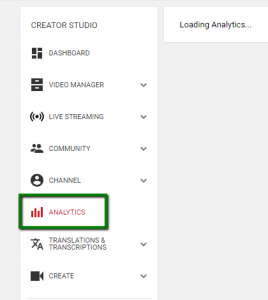
Despite being well hidden, it contains a nuclear submarine’s worth of dashboards & reports offering insights into all areas needed for fruitful analysis, including the ability to compare videos against each other. If your video isn’t performing in video search, chances are good that the answer is here.
For example, you might find that you’re losing viewers just a few seconds after the video starts. This is likely an indication that your video is not what users are expecting to see – or that it’s really really rubbish.
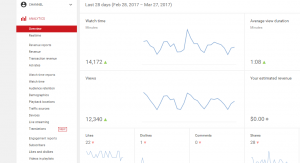
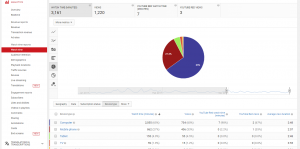
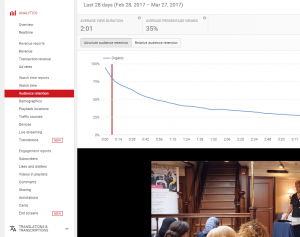
So, you’ve reviewed the analytics. You’ve done some soul searching. Is your video a rusty shopping trolley which has made its way down the Humber estuary and sunk to the ocean floor? If it is, don’t blame yourself – chalk it up to experience and have another go.
However, if your un-ranked video is a gold doubloon from a Spanish galleon which has unjustly been condemned to the murky depths, depriving the world of its beauty, ask yourself this:

Who needs to watch my video?
There are a lot of beautifully produced videos out there which nobody sees. This is because they’re about things which nobody is interested in. YouTube’s abyssal plain is littered with jewels like this because the people behind the projects were video producers, not digital marketers, and couldn’t have been expected to know any better. Here are the questions they should have asked themselves:
What’s my target keyword topic? – By making your video about a specific defined topic, it’s easier to match it to real-world demand for content using specific words or phrases which can be used in optimising your video for YouTube success. If you’re looking for fruitful keyword ideas, try YouTube autocomplete. It’s unwieldy to use for research purposes but the data is bang up to date and very useful.
Does Google view my keyword as a video keyword? – Google shows video results in its main web search results to varying extents depending on the keyword. Keywords which show many videos in the web SERPs are deemed highly relevant to video, and have the benefit of providing viewers not just from YouTube but from Google’s main web SERPs. You don’t have to choose these video keywords when making your video but if you’re planning on creating a video in order to generate maximum exposure for your brand, it certainly helps. Videos keywords are often associated with reviews, how to guides, tutorials, fun / entertainment & sports / fitness to name but a few.
Is there adequate search volume? – Before committing production resource, AdWords Keyword Planner should be consulted but this is far from the only source of information:
- Google trends – While this only shows the popularity of a keyword or topic in relative terms, it’s still useful for comparing one prospective topic against another. Trends recently introduced the ability to see only data for video searches.
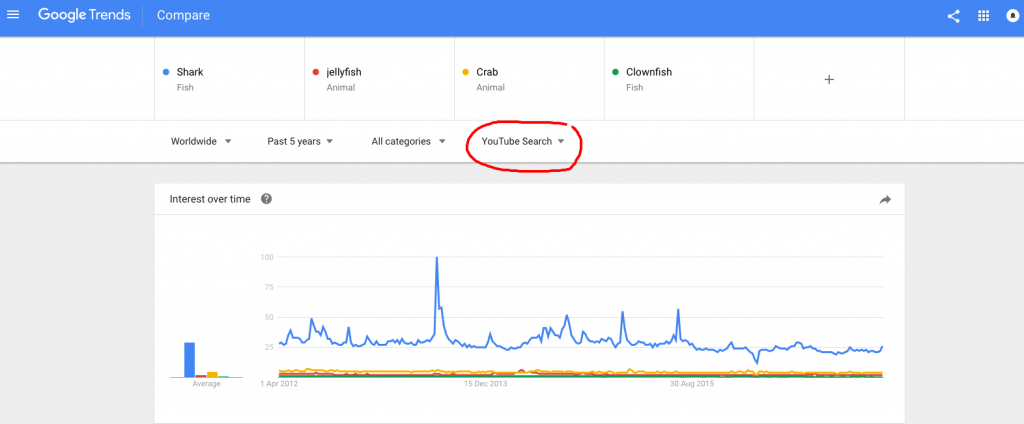
- Display planner – Since shelving YouTube Keyword Planner, Google has recommended that marketers use the display planner instead. There is a learning curve but it does provide insight into demand for some of the more general video topics and keywords.
If you’ve planned and researched your YouTube video expedition to the utmost and still aren’t making waves in organic video search, don’t be discouraged. There’s still a boatload of YouTube SEO tactics for you to unleash:
Have you optimised your YouTube video so Google can understand what it’s about?
Creatures in the deep sea commonly defy classification. Like the sea mushroom, they lack the attributes marine biologists need in order to place them in the context of the tree of life. In much the same way, Google cannot place your video in the correct context in its search results and serve it to searchers without clear identifying attributes. It cannot understand what videos are about just by “watching” them (yet). It needs help from you, the heroic YouTube uploader, in the form of YouTube optimisation. Here’s how you can make sure your video isn’t relegated to the book of unclassifiable marine oddities:
Title
The most important optimisation attribute for any video. Put your most important keywords at the front of the title. Directly address you target audience’s needs. Make ’em click.
Description
Tell your audience (and Google) what your video is about, how it will help them, and where they can get more information.
- Put a link to your website near the top of the description to maximise click-throughs.
- Make it at least 250 words
- Use your keywords in the description – 3 times, maybe 4 if it’s long, should do the trick.
Tags
The main role of these is to allow your video to appear in the “related video” lists when users watch other videos. Make sure your tags relate your video to more popular videos out there which attract your target audience.
- Use your keywords to inspire your tags but don’t be limited to them.
- Some cheeky YouTube video optimisers add their competitors’ channel name as a tag, making it more likely that their video will appear as a related video on the sidebar which shows for their competitors’ videos.
Filename
Your video’s filename should represent its content – just one more source of information Google can use to determine what your video is about.
Video thumbnail
Sometimes, the first frame of your video is a beautiful summary of the what the video is about, in which case no action is required. Usually however, it’s just a bush or a blank screen which gives little indication as to what the video is about. Choosing your own eye-catching thumbnail will maximise click-throughs to your video.
Conquering the Channel – Is your house in order?
Laboured puns aside, having a well optimised channel can do wonders for your YouTube SEO.
Here are the key elements:
- Channel description – Provide a long keyword rich detailed description of your channel – why does it exist, who is it for, what problems does it solve?
- Channel keywords – Give Google a clue as to the sorts of keywords your channel is targeting. Lots of YouTube marketers miss this – get the edge by optimising here.
- Playlist organisation – Organising your channel’s videos into playlists is an instant plus in terms of user engagement – instead of sifting through a seemingly random list of videos, they’ll find it easy to find what they are looking for and be more likely to stick around and interact.
- Custom URL – Channels with at least 500 subscribers (recently introduced) can change their channel’s URL from the random string of numbers and letters to something more user friendly and shareable. Make sure you don’t miss this.

Plumbing the depths – Little-used YouTube optimisation features from Davy Jones’s Locker
YouTube’s interface can be a challenge to navigate for the YouTube SEO newcomer. You may not be aware of these handy features which can make a real difference to your video’s performance.
Closed captions
Google automatically tries to transcribe the words in your video for the benefit of hard-of-hearing viewers as-well as to aid its own comprehension. If you hired Sir David Attenborough to narrate your skateboarding tutorial, you’ve got little to worry about – Google will fairly accurately transcribe Attenborough’s impeccably spoken words into text which it will then use to help it understand what your video is about, helping your video rank better in video search.
However, if you didn’t hire Attenborough, the accuracy with which Google will be able to transcribe your video’s spoken element is let us just say not guaranteed.
Even Jeremy Clarkson’s dulcet tones did little to help the transcription algorithm.
But there’s great news here – Google’s transcription can be edited! This truly is a bonanza for the YouTube optimiser – you may find on viewing the transcription that Google has been unable to recognise your key phrases. Simply editing these could go a long way to improving your YouTube video’s optimisation, but I’d go the whole hog if a lot of resource has been invested in the video.
Featured content
If you’ve ever watched documentaries on sharks or have watched them out in the water, you’ve probably noticed their smaller companions, remora fish. These fish attach themselves to the larger marine creatures including sharks, turtles, manta rays and the like for an easy mode of transportation, to gain the protection provided by being one with the bigger animal, and for food. Similarly to the Remora fish, your new videos can get a helping hand – provided you have some bigger fish in your tank.
Do you have videos which are already popular but can’t get your new video to succeed? Then YouTube’s featured content option is for you. It lets you show a little teaser ad in the bottom left corner of your existing popular videos which encourages viewers to see the new video. It’s quite enticing and successfully drives click-throughs. Your new videos will benefit from the success of established ones.
YouTube SEO is your video’s life raft. Now that you’re an expert, it’s time for you to surface your video and achieve great rankings on YouTube and Google Video search. Anchors aweigh!



